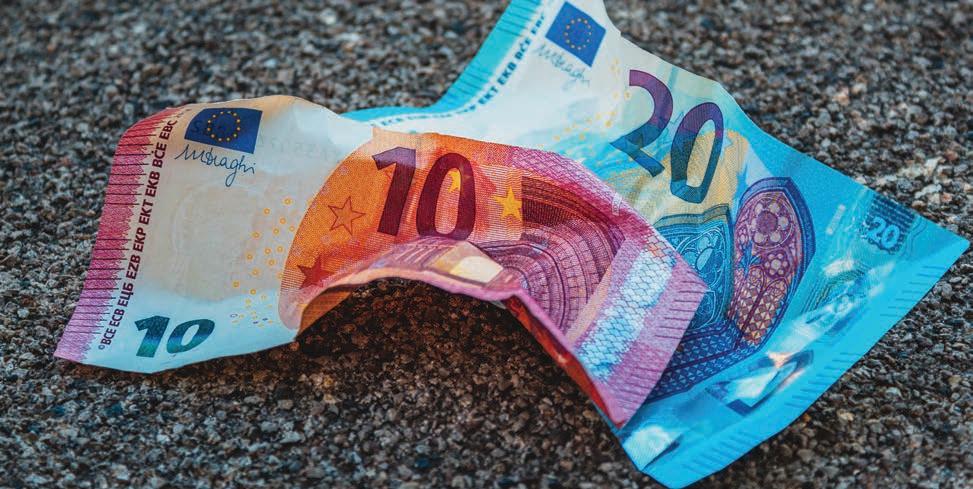
8 minute read
Paul Hopkins
The Fact OfThe Matter

Advertisement


PAUL HOPKINS PAUL HOPKINS Why the Angelus still chimes for most of us
Right, let us pause for the Angelus, my father would say, the fork-full of beans on toast suspended midway to my mouth, my younger brother kicking me under the table. And so we paused. Froze. Perfectly still, like the painted picture on the old black-andwhite telly in the diningroom corner, the image of Madonna and Child accompanying the peal of the bells as the Angelus rang out the length and breadth of Holy Catholic Ireland, courtesy of the then fledgling Radio Telefis Eireann.
I bet God doesn’t stop eating his tea just ‘cos the Angelus is ringing, I thought, as my brother made another swipe at my shin, and I inwardly asked forgiveness for my blasphemy. Meantime, that lifetime ago, in the seemingly comforting cocoon of a dominant Catholic and predominantly rural Ireland of the 1950s and 60s, the nation virtually came to a standstill for one whole minute twice a day, noon and evening, for the ringing of the Angelus.
I am reminded of this still from my life, as an RTE/ Red C exit poll a little while back shows that two out of three people interviewed want to keep the Angelus. Asked, “Should RTÉ stop or should it keep broadcasting the Angelus?”, 68% said it should be kept, 21% said it should go, and 11% declined to answer.
It’s a debate that religiously comes up annually: Should the Angelus be scrapped?
The one-minute reflection on RTÉ One has been aired daily at 6pm since the inception of national television in 1962, while the famous bells are also broadcast on RTÉ radio at noon and 6pm. Since 2015 the Angelus has been accompanied by more secular imagery which famously led Senator David Norris to remark in the Seanad that this was “hogwash”, stating: “It is and should remain Christian.”
Atheist Ireland once annually calls for the national broadcaster to discontinue ‘ringing’ the Angelus because it is an affront to an increasing secular and/or multi-religious society. An anachronism, they argue – a throwback to more homogeneously and observantly Christian times.
At the very least, Atheist Ireland – a loose consortium of like-minded nonbelievers founded in 2006 and a member of Atheist Alliance International – believes RTE should change the name of the Angelus. Changing the title “would be an important first step to creating a genuinely inclusive and religiously neutral moment of reflection,” it argues.
The head of religious programmes at RTE had previously said the Broadcasting Authority of Ireland had ruled it is totally defensible to retain the 18 peals of the Angelus bell during the “moment of reflection, as well as continuing to call it the Angelus”.
Its origins as a daily devotion of sorts by the national broadcaster go back to 1948 and Leon O Broin, the then secretary of the Department of Posts and Telegraphs, who oversaw broadcasting. He discussed the idea of a daily spoken Angelus with the Catholic Archbishop of Dublin, the infamous John Charles McQuaid.
The idea was rejected, but an alternative of experimenting with the sound of a bell was considered. Once the principle of the broadcast was agreed, how it was to be done was purely an engineering matter.
For centuries, an integral part of the mythos and vernacular of Roman Catholicism, the relevance today of the Angelus, despite the aforementioned poll’s result, can best be described as an anachronism. And a harmless one at that.
A simple, quiet minute or so in a day that allows time to reflect and take stock. To, as someone in the Bible wrote, “be still and know that I am God”.
Of all of the things offensive about Ireland’s unhealthy relationship with Catholicism, the Angelus is the least of them.


Glanbia's nutri-biz 'worth €3bn'
Glanbia's performance nutrition business, GPN, could be worth up to €3bn based on multiples achieved by its peers, market sources have told the Sunday Independent. e valuation of the Irish food and nutrition company is likely to attract increased scrutiny after it emerged last week that activist shareholder Frankfurt-based Clearway Capital had taken a position in the company. e fund, founded by Gianluca Ferrari, has not yet declared its stake, suggesting the holding is below the 3pc threshold where investors have to publicly reveal a holding to the stock market.
Glanbia PLC's market capitalisation is around €3bn at the moment, but some sources believe that the GPN business alone could be worth close to this. Glanbia has some of the strongest brands in the whey protein space but has disappointed some investors in terms of innovation and expansion outside of the US. e other division, Glanbia Nutritionals - which houses its American cheese business - in addition to joint ventures, could be worth around €1.7bn, based on industry ratings. is suggests there could be a valuation for the group of €4.6bn and a premium of 30% to 40% on ursday, April 21share price, the day Bloomberg rst reported the holding.
As previously reported in the Sunday Independent, a break-up of the business could unlock this value. A trade sale of GPN is one option, while a share distribution, facilitated by a separate listing of GPN, is among the ways in which the protein division could realise a higher valuation.
Clearway has not commented on its investment but typically such funds will make contact with other shareholders to rally support, in addition to seeking change from management.
Irish spirits are vying for US
Bord Bia has o cially launched its new Spirit of Ireland drinks campaign in the US as part of the Government’s trade mission to North America and Mexico. It is the single largest investment Bord Bia has made to date in the promotion of Irish spirits.
Spirit of Ireland is an educational programme aimed at US customer-facing sta selling Irish spirits in o -licenses and bars. e €750,000 trade communications campaign comprises virtual reality tours of 20 of Ireland’s distilleries, featuring interviews with master distillers and barrel coopers so sta can learn rst-hand from brand owners in Ireland what makes their product unique and distinctive. e campaign o ers a unique sensory experience using “scratch and sni ” cards to smell and experience barley elds and barrel houses, all aimed at creating an in-depth understanding of Irish spirits. e campaign will be rolled out with 17 liquor control boards in the US.


Inflation... going forward
Ibec, the group that represents Irish business, has published its latest Economic Outlook report, forecasting economic growth of approximately 4.3% in the year ahead, a decrease from the 6.1% that was predicted for 2022 in Q4 2021. The revised forecasts come largely as a result of the economic impact from rising costs and supply chain challenges across the global economy, accelerated by the Russian invasion of Ukraine.
Speaking at the launch of the report, Ibec Chief Economist and Head of National Policy Gerard Brady said: “Despite the downward revision in our forecasts, it is important to acknowledge that our underlying business model remains strong and can deliver growth. "However, the global environment will drag on growth this year and next, with rising energy costs, record commodity and transport costs and global supply chain challenges resulting in a slowing of business investment and lower than previously expected consumer spending," he said.
“Even if inflation growth slows, the level of energy, transport and commodity prices will now remain much higher for longer. The net impact of this in economic terms is both a relative price shock for consumers – reducing spending elsewhere – and the postponement and re-evaluation of investments in businesses and construction.
“Ibec is calling on Government to intensify work through the Labour Employer Economic Forum to ensure better coordination and targeting of tax, social welfare and other labour market policies that can address inflationary pressures," Mr Brady said.
MII welcomes move on lamb access to US
Meat Industry Ireland (MII) has welcomed the progress made on access to the US market for Irish lamb but has warned that action is needed to address quota barriers to beef exports. e lamb import market in the US is over 160,000 tonnes and is currently dominated by imports from Australia and New Zealand. Last year, Ireland’s beef exports to the US were valued at €36m, but unless the import quota roadblock is resolved this will not be repeated in 2022.
Irish lamb should now be on shelves in the coming months once the nal stages of completing access requirements are completed. Irish lamb processors are currently working with the authorities to have facilities approved, following Sunday’s announcement by the Minister for Agriculture Charlie McConalogue TD of an agreement on a sheepmeat export health certi cate for the US.
A key concern MII is raising on the trip relates to the disruption of Irish beef exports to the US due to the import market being swamped by Brazilian beef. Due to the return of Brazilian beef in the US market, the import quota that importers of Irish beef use, which would normally ll up towards the end of each year was completely lled by early April this year. is now presents a major di culty for Irish beef to enter the US market competitively. Outside of the quota, Irish beef faces an import duty of 26.4% which e ectively blocks trade into a beef import market of over 1m tonnes.
MII will meet Minister McConalogue on this issue ahead of his meetings with US authorities.










